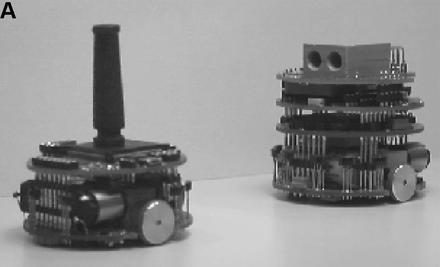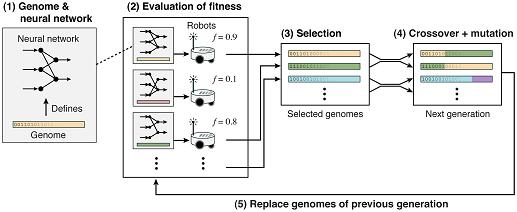February 5, 2010
Evolutionary Robotics: The Rise of the Darwinian Machines
Source: Public Library of Science PLoS Biology, via CNET Crave.

Robots do evolve, and Chuck D. thanks them. Two Swiss researchers set out on what could be called an ambitious project: To show that robots can evolve like organic creatures… and piss off the creationists. While their work is considerably simpler than trying to evolve humans out of chimps, it does pave the way for better understanding organic evolution…
… and for a possible robot takeover of the world, or (if humanity is lucky enough) the emergence of the Borg.
You can check out the details from the PLoS site where you can download the PDF or XMS for leisurely reading offline. Caution: It is a scholarly work.
The results are in. In their experiments, the researchers used a “darwinian algorithm.”

This “algorithm” shows how the robots evolved during the various tasks they performed. Those tasks were navigation, homing, predation, brain and body morphology, and foraging (cooperation and altruism).
They found that, after a couple of hundred “generations” (loops of the algorithm), the bots were able to move through a maze without bumping into walls, adapt and change strategies for hunting and evasion, find their way “home,” and adapt to new bodies. They even found that, during the foraging exercises, the robots were able to cooperate in the task, and some even sacrificed personal gain for group gain.
These examples of experimental evolution with robots verify the power of evolution by mutation, recombination, and natural selection. In all cases, robots initially exhibited completely uncoordinated behaviour because their genomes had random values. However, a few hundreds of generations of random mutations and selective reproduction were sufficient to promote the evolution of efficient behaviours in a wide range of environmental conditions. The ability of robots to orientate, escape predators, and even cooperate is particularly remarkable given that they had deliberately simple genotypes directly mapped into the connection weights of neural networks comprising only a few dozen neurons.
It’s official… Humanity is SCREWED. Not quite yet…
As stated, it took these robots several hundred generations to do seemingly “simple” tasks. Humans have been at it for several thousand generations (and they still find ways of mucking things up). So it will be some time before we see a Cyberdyne series 800 model 101 walking down the street with an Uzi in each hand…
In the meantime, other scientists can use this new field of Evolutionary Robotics to further their studies…
and piss off the creationists.




